Incline Chest Fly Machine Overview
The incline chest fly machine is an isolation exercise that targets the upper chest muscles, specifically the pectoralis major muscle.
It typically consists of a bench or seat set at an inclined angle (usually around 30 to 45 degrees) and handles or levers connected to a weight stack or resistance system. The incline position places more emphasis on the clavicular (upper) fibers of the pectoralis major, helping to develop and strengthen that area of the chest. It’s often used in strength training to isolate the chest muscles and promote muscle growth and definition in the upper chest region.
How to do:

1. Adjust the Machine:
- Set the machine’s seat and arms to an incline that targets your upper chest. Ensure that the handles are positioned at a height comfortable for your reach.
2. Seat Positioning:
- Sit on the machine with your back flat against the backrest and your feet firmly planted on the floor. Grab the handles with an overhand grip, palms facing inward.
3. Initial Position:
- Start with your arms extended straight out to the sides, slightly bent at the elbows. Your elbows should be at a level slightly below your shoulders.
4. Movement:
- Keeping a slight bend in your elbows, exhale and bring the handles or levers together in front of you. Focus on using your chest muscles to perform the movement. Visualize hugging a large tree as you bring your arms together.
5. Contraction:
- Hold the fully contracted position for a moment, feeling the tension in your chest muscles.
6. Return:
- Inhale and slowly reverse the movement, bringing your arms back to the starting position in a controlled manner. Ensure a smooth and controlled motion without locking out your elbows.
7. Repeat:
- Aim for a specific number of repetitions and sets, considering a weight that challenges your muscles without compromising your form.
Form Tips:
- Ensure a smooth, controlled motion during both the concentric (bringing the handles together) and eccentric (returning to starting position) phases of the exercise.
- Keep your back and head against the machine’s backrest.
- Engage your chest muscles throughout the movement, and do not rely on your shoulders or arms to lift the weight. Focus on feeling the stretch and contraction in your chest muscles with each repetition.
- Do not fully lock your elbows at the end of the motion to avoid unnecessary strain on the joints.
- Avoid using momentum or swinging your body to complete the movement.
- Adjust the weight according to your strength level, starting lighter if you’re new to the exercise and increasing gradually as you get more comfortable with the movement.
Benefits of Incline Chest Fly Machine
1. Targeted Upper Chest Development:
The incline angle focuses on the upper chest, specifically the clavicular fibers of the pectoralis major. This helps in sculpting and strengthening the upper chest region, providing a balanced and aesthetic chest shape.
2. Isolation of Chest Muscles:
It primarily engages the chest muscles (pectorals) while minimizing the involvement of other muscle groups. This isolation can help in concentrated chest muscle development.
3. Variation in Chest Workout:
It offers a different angle compared to traditional flat bench exercises, providing variety in your chest workout routine. Changing angles can prevent muscle adaptation and plateauing, leading to continued progress.
4. Enhanced Stretch and Range of Motion:
The machine allows for a deeper stretch at the bottom of the movement, enhancing the range of motion for the chest muscles. This can improve flexibility and muscle engagement.
5. Controlled and Safer Movements:
Using a machine can help maintain proper form and control throughout the exercise, reducing the risk of injury compared to free weights where stabilizing muscles might be at risk.
6. Suitable for Beginners:
It can be a good starting point for beginners to get used to chest exercises. The machine’s guided movement helps individuals understand the proper motion and muscle engagement required for chest exercises.
Incline Chest Fly Machine – Muscles Worked
The incline chest fly machine primarily targets the upper chest muscles, specifically the clavicular (upper) fibers of the pectoralis major. It also engages several other muscles to stabilize and assist in the movement. Here are the main muscles worked during the incline chest fly machine exercise:

